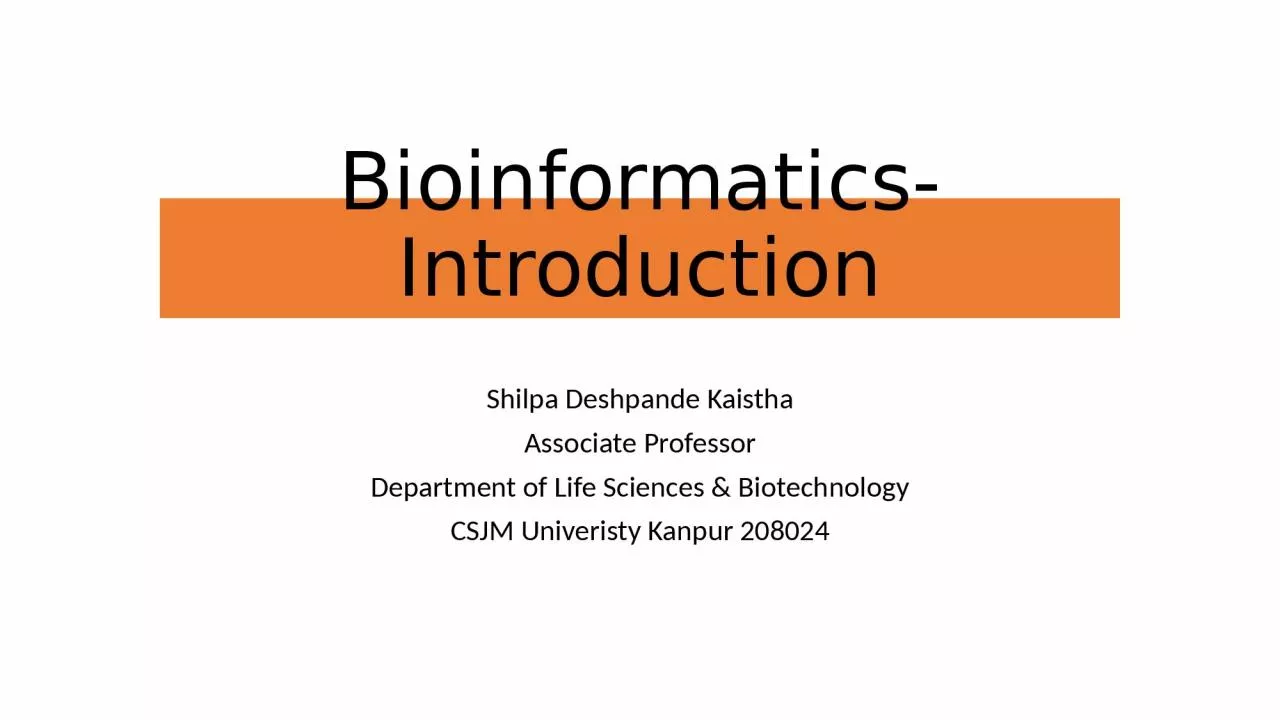

Shilpa Deshpande Kaistha Associate Professor Department of Life Sciences amp Biotechnology CSJM Univeristy Kanpur 208024 Introduction The term bioinformatics was coined by Paulien ID: 1007163
Download Presentation The PPT/PDF document "Bioinformatics- Introduction" is the property of its rightful owner. Permission is granted to download and print the materials on this web site for personal, non-commercial use only, and to display it on your personal computer provided you do not modify the materials and that you retain all copyright notices contained in the materials. By downloading content from our website, you accept the terms of this agreement.
1. Bioinformatics- IntroductionShilpa Deshpande KaisthaAssociate ProfessorDepartment of Life Sciences & BiotechnologyCSJM Univeristy Kanpur 208024
2. IntroductionThe term bioinformatics was coined by Paulien Hogeweg in 1979 for the study of informatic processes in biotic systemsBioinformatics is a hybrid branch of biology and information technology or it can be said that it encompasses the knowledge of computer science, statistics, mathematics, chemistry, biochemistry , physics and linguistic. Bioinformatics is the science of developing computer databases and algorithms for the purpose of speeding up and enhancing biological research. The National Center for Biotechnology Information (NCBI, 2001) defines bioinformatics as "Bioinformatics is the field of science in which biology, computer science, and information technology merge into a single discipline”
3. BioinformaticsStorage of biological data in the form of databases to facilitate easy retrieval and submission of new entries Tool and resource development for data analysis eg BLAST, Primer3, ORF FinderExploitation of computational tools to analyse biological data Interpret analysed data in a meaningful manner and present it to the userTwo major typesComputational bioinformatics: developing software and algorithms to solve biological problemsApplication bioinformatics: Deals with sequence & structure analysis for functional analysis of biomolecules
4. ReferenceWhat is bioinformatics? A proposed definition and overview of the field. NM Luscombe, D Greenbaum, M Gerstein (2001) Methods Inf Med 40: 346-58. Bioinformatic Sequence and Genome Analysis. David Mount Cold Spring Harbor Laboratory Press, US
5. Margaret DayhoffMargaret Dayhoff and her collaborators in 1960s at the National Biomedical Research Foundation (NBRF), Washington, D.C., after the development of protein sequencing method by Sanger and Tuppy (1951), organized proteins into families and superfamilies on the basis of degree of sequence similarities. They assembled the databases of protein sequences into a protein sequence atlas and their collection centre became popular as Protein Information Resource (PIR). They also contributed Percent Accepted Mutation (PAM) table for comparison of protein sequences of various organisms. Dayhoff and her associates contributed a lot to modern biological sequence analysis by providing the first protein sequence database and PAM table. Margaret Dayhoff is regarded as founder of bioinformatics.
6. George BellIn 1974, Theoretical Biology and Biophysics Group founded by George I. Bell at Los Alamos National Laboratory in New Mexico initiated collection of DNA sequence into the GenBank data base to provide theoretical background to experimental work mainly in the field of immunology. The information on protein sequence and DNA sequence stored in data bases were made accessible for public by developing Web pages. An early example of this technology at NCBI was GENINFO developed by D. Benson, D. Lipman and colleagues.
7. Programs for Biological DatabasesDerivative program called Entrez http://www.ncbi.nim.nih.gov/Entrez) was developed at NCBI. To facilitate accurate data collection the programs Phred and Phrad were developed by Phil Green and colleagues at the University of Washington to assist with reading and processing DNA sequencing data. In 1970, A.J. Gibbs and G.A. McIntyre described a new method – dot matrix method for comparing two amino acids and nucleotide sequences.
8. Needleman and WunschNeedleman and Wunsch proposed dynamic programming in 1970 for sequence alignment which could give best alignment of two sequences having match, mismatch, single insertion and deletion. The programme fixed score 1 for every match, 0 for every mismatch and penalty score for every individual gap. These scores were then added across the alignment to get total score for the alignment. The alignment with highest possible score was defined as the optimal alignment.Notredame and his colleagues (2000) developed multiple sequence alignment program s for aligning three or more sequences at a time.
9. RNA databasesIn 1971, Tinoco and his colleagues developed computer based method for predicting RNA secondary structure. Subsequently, Nussinor and Jacobson in 1980, on the basis of algorithm used for aligning DNA and protein sequences developed a fast and efficient computer based method to predict RNA molecules with number of base pairs. This method was further improved by Zuker and Stiegler in 1981. In 1987 database of rRNA molecules was prepared by the laboratory of C. Woese (http://www.cme.msu.edu/RDP.html/inde.html).
10. FASTA and BLASTW. Pearson and D. Lipman in 1988 developed a fast computer based program – FASTA. FASTA facilitate similarity search between newly sequenced DNA, RNA and protein with model sequence already present in respective databases. Pearson further improved FASTA program in the year 1990 and 1996. In 1990 a similar program for similarity searching in sequence database called BLAST was developed by S. Attschul and his colleagues. This method is widely used from the web site of the NCBI (http://www.ncbi.nlm.nih.gov/BLAST). BLAST is the most widely used server for searching sequence similarity
11. PDBProtein Data BankWith the development of fast and efficient computational method in Feb, 2004 there were more than 22,044 protein structures deposited in the Brookhaven Protein Data Bank (PDB) and 144,731 protein sequence entries in the SwissProt protein sequence database.
12. Genome Sequencing ProjectsComplete genome of Hemophilus influenzae was sequenced in the Institute of Genetics Research (TIGR, at http://www.tigr.org/) and was started by Craig Venter. Success of this project had initiated other sequencing projects of various prokaryotic and eukaryotic genomes including Human Genome Project (HGP).AceDB was a genome database management system developed in 1989 by Jean Thierry-Mieg (CNRS, Montpellier) and Richard Durben (Sanger Institute).Saccharomyces cerevisiae database
13.
14.
15.